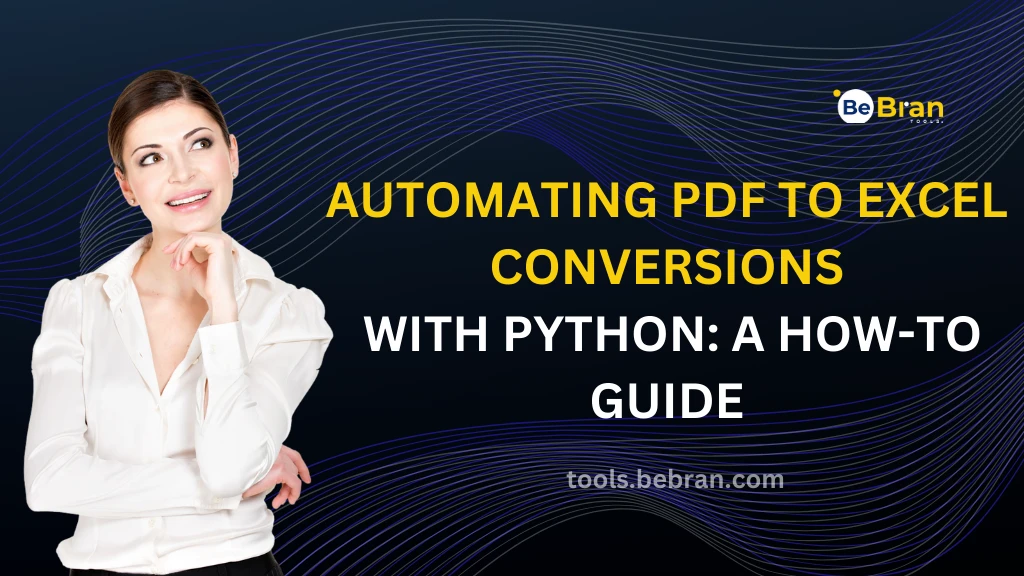
Automating PDF to Excel Conversions with Python: A How-To Guide
Are you tired of manually extracting data from PDFs into Excel sheets? The endless copy-pasting, formatting errors, and time-consuming tasks can be overwhelming. But fear not! Python comes to the rescue with its incredible libraries that streamline PDF to Excel conversions. Let's delve into this handy guide to automate the process effortlessly, Understanding the Need for Automating PDF to Excel conversion.
Why Automate PDF to Excel?
Picture this: a mountain of PDF documents containing crucial data, and the need to extract and organize it efficiently into Excel sheets. Manually accomplishing this task is not only arduous but also prone to errors. Automating this process saves time, reduces errors, and enhances productivity.
- Efficiency Boost: Python's automation capabilities significantly increase efficiency. By eliminating manual intervention, errors are minimized, enabling quicker data extraction and analysis.
- Error Reduction: Human error is inevitable in manual data extraction. Python automation ensures accuracy, reducing the risk of errors that could affect decision-making.
Explore More: Merging PDFs on Mac: The Quick and Easy Way | Keyword Density Checker Tools for Different CMS Platforms
Python Libraries for Conversion
tabula-py is a powerful library for extracting tables from PDFs. Its ability to identify and extract tabular data simplifies the extraction process.
- Installation and Usage: Installing tabula-py is simple with Python's package manager, pip. Once installed, usage involves loading a PDF and specifying the area to extract data from, enabling seamless extraction into Excel format.
- Utilizing PyPDF2 for Text Extraction: The PyPDF2 library aids in extracting textual content from PDFs. While it's not table-specific, it assists in extracting text-based data for conversion into Excel.
Implementation

Installation of PyPDF2 follows a similar process to other Python libraries. By identifying text patterns or regions, this library assists in extracting data for Excel conversion.
Step-by-Step Guide to Automating PDF to Excel Conversions
Benefits of Automating PDF to Excel Conversion with Python
By automating the conversion process, valuable time is saved, allowing focus on more critical tasks. Python automation ensures accurate and consistent data extraction, eliminating human errors prevalent in manual tasks. This automated process is easily scalable to handle large volumes of PDFs, making it adaptable to various data extraction needs.
Free Tools: Free IP Address Location Tool Online | Free Get HTTP Header Tool Online
Conclusion
Converting PDFs to Excel need not be a tedious, error-prone task anymore. Python's libraries, such as tabula-py and PyPDF2, empower users to automate the process efficiently. By following the step-by-step guide outlined here, you can streamline data extraction, saving time and ensuring accuracy. Embrace Python automation and bid farewell to manual data entry woes!
Crafting an efficient PDF-to-Excel conversion process using Python has become an essential skill in today's data-driven world. With the right tools and understanding, automating this task proves to be a game-changer in improving productivity and accuracy. Harness the power of Python and simplify your data extraction journey!
Also Read: Choosing the Right Keywords Rich Domains Tool: Top Picks and Features | The Ultimate Guide to Converting Word Documents to PDF converter
Frequently Asked Questions
1: What is Python, and why use it for PDF to Excel conversions?
Python is a versatile programming language known for its simplicity and readability. It's ideal for automating tasks, including PDF to Excel conversions, due to its extensive libraries and easy-to-understand syntax.
2: Do I need coding experience to use Python for PDF to Excel automation?
While prior coding experience can be beneficial, Python offers user-friendly libraries like PyPDF2 and pandas, accompanied by comprehensive documentation and online resources, making it accessible for beginners.
3: How does Python help in automating PDF to Excel conversions?
Python allows the creation of scripts that utilize libraries like PyPDF2 to extract data from PDFs and pandas to organize and export it into Excel files, streamlining the conversion process.
4: Are there specific libraries or tools needed for PDF to Excel conversions using Python?
Yes, libraries like PyPDF2 for PDF manipulation and pandas for data manipulation are commonly used. These libraries simplify data extraction and organization for seamless PDF to Excel conversions.
5: Can Python automate batch PDF to Excel conversions?
Absolutely! With Python scripts, you can automate the conversion of multiple PDF files into Excel simultaneously, significantly enhancing efficiency, especially when dealing with large volumes of data.
6: Is Python compatible with different operating systems for PDF to Excel conversions?
Yes, Python is highly compatible and works across various operating systems like Windows, macOS, and Linux, ensuring versatility and accessibility for users.
7: How reliable is Python in accurately converting PDFs to Excel?
Python, when correctly implemented and configured, is highly reliable in converting PDFs to Excel. However, accuracy may depend on the complexity and formatting of the original PDF document.
8: Can Python handle complex PDF structures during the conversion process?
Yes, Python's libraries can handle varying complexities in PDF structures, but it may require specific configurations or additional code for intricate layouts or unique data structures.
9: Are there any limitations when using Python for PDF to Excel conversions?
While Python is robust, certain limitations may arise with highly complex or encrypted PDFs, requiring additional steps or manual intervention for successful conversions.
10: Is Python open-source and free to use for PDF to Excel automation?
Yes, Python is an open-source language and is free to use. Its extensive community support and regular updates contribute to its widespread adoption for various automation tasks.
11: Where can I find resources to learn Python for PDF to Excel conversions?
Numerous online tutorials, documentation, forums, and dedicated websites offer guidance and resources for learning Python specifically for automating PDF to Excel conversions.
Q12: Can I customize Python scripts for specific PDF to Excel conversion requirements?
Absolutely! Python's flexibility allows users to tailor scripts to meet specific needs, enabling customization for various PDF formats or unique conversion demands.



